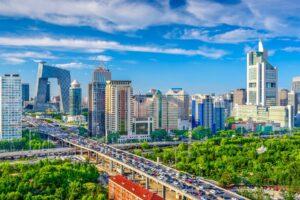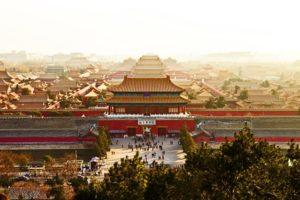Fodor's Expert Review The Forbidden City
Undeniably sumptuous, the Forbidden City, once home to a long line of emperors, is Beijing's most enduring emblem. Magnificent halls, winding lanes, and stately courtyards await you. At 180 acres, this is the world's largest palace complex.
As you gaze up at roofs of glazed-yellow tiles—a symbol of royalty—try to imagine a time when only the emperor ("the son of God") was permitted to enter this palace, accompanied by select family members, concubines, and eunuchs, used as servants. Now, with its doors flung open, the Forbidden City's mysteries beckon.
The sheer grandeur of the site—with 800 buildings and a rumored 9,999 rooms—conveys the pomp of Imperial China. The shady palaces, musty with age, recall the tedium of life at court was relieved by gossip and scheming.
The most impressive way to reach the Forbidden City is through the imposing Gate of Heavenly Peace (Tiananmen), connected to Tiananmen Square.... READ MORE
Undeniably sumptuous, the Forbidden City, once home to a long line of emperors, is Beijing's most enduring emblem. Magnificent halls, winding lanes, and stately courtyards await you. At 180 acres, this is the world's largest palace complex.
As you gaze up at roofs of glazed-yellow tiles—a symbol of royalty—try to imagine a time when only the emperor ("the son of God") was permitted to enter this palace, accompanied by select family members, concubines, and eunuchs, used as servants. Now, with its doors flung open, the Forbidden City's mysteries beckon.
The sheer grandeur of the site—with 800 buildings and a rumored 9,999 rooms—conveys the pomp of Imperial China. The shady palaces, musty with age, recall the tedium of life at court was relieved by gossip and scheming.
The most impressive way to reach the Forbidden City is through the imposing Gate of Heavenly Peace (Tiananmen), connected to Tiananmen Square. The Great Helmsman himself stood here to establish the People's Republic of China on October 1, 1949, and again to review millions of Red Guards during the Cultural Revolution. Ascend the gate for a dramatic view of the square. You must check your bags prior to entry and also pass through a metal detector.
The Meridian Gate (Wumen), sometimes called Five Phoenix Tower, is the main southern entrance to the palace. Here, the emperor announced yearly planting schedules according to the lunar calendar; it's also where errant officials were flogged. The main ticket and audio-guide offices are just west of this gate.
The Hall of Supreme Harmony (Taihedian) was used for coronations, royal birthdays, and weddings. Bronze vats, once kept brimming with water to fight fires, ring this vast expanse. The hall sits atop three stone tiers with an elaborate drainage system with 1,000 carved dragons. On the top tier, bronze cranes symbolize longevity. Inside, cloisonné cranes flank the imperial throne, above which hangs a heavy bronze ball—placed there to crush any pretender to the throne.
Emperors greeted audiences and held banquets in the Hall of Middle Harmony (Zhonghedian). It also housed the royal plow, with which the emperor himself would turn a furrow to commence spring planting.
The highest civil service examinations, which were personally conducted by the emperor, were once administered in the Hall of Preserving Harmony (Baohedian). Behind the hall, a 200-ton marble relief of nine dragons, the palace's most treasured stone carving, adorns the descending staircase.
A short jaunt to the right is the Hall of Clocks and Watches (Zhongbiaoguan), where you'll find a collection of early timepieces. It's pure opulence, with jeweled, enameled, and lacquered timepieces (some astride elephants, others implanted in ceramic trees). Our favorites? Those crafted from red sandalwood.
Now you're approaching the very core of the palace. Several emperors chose to live in the Inner Palace with their families. The Hall of Heavenly Purity (Qianqinggong) holds another imperial throne; the Hall of Union and Peace (Jiaotaidian) was the venue for the empress's annual birthday party; and the Palace of Earthly Peace (Kunninggong) was the empress's residence and also was where royal couples consummated their marriages. The banner above the throne bizarrely reads DOING NOTHING.
On either side of the Inner Palace are six western and six eastern palaces—the former living quarters of concubines and servants. The last building on the western side, the Hall of Mental Cultivation (Yangxindian), is the most important of these. Starting with Emperor Yongzheng, all Qing Dynasty emperors attended to daily state business in this hall.
The Gallery of Treasures (Zhenbaoguan), actually a series of halls, has breathtaking examples of imperial ornamentation. The first room displays candleholders, wine vessels, tea sets, and a golden pagoda commissioned by Qing emperor Qianlong in honor of his mother. A cabinet on one wall contains the 25 imperial seals. Jade bracelets, golden hairpins, and coral fill the second hall; carved jade landscapes a third.
North of Forbidden City's private palaces, beyond the Gate of Earthly Tranquility (Kunningmen), lies the most pleasant part of the Forbidden City: the Imperial Gardens (Yuhuayuan), composed of ancient cypress trees and stone mosaic pathways. During festivals, the emperors, empresses, and concubines all scrambled to the top of the strange rock hill in the northwest of the gardens, called the Hill of Accumulated Elegance. You can exit the palace at the back of the gardens through the park's Gate of the Divine Warrior (Shenwumen).
READ LESS







